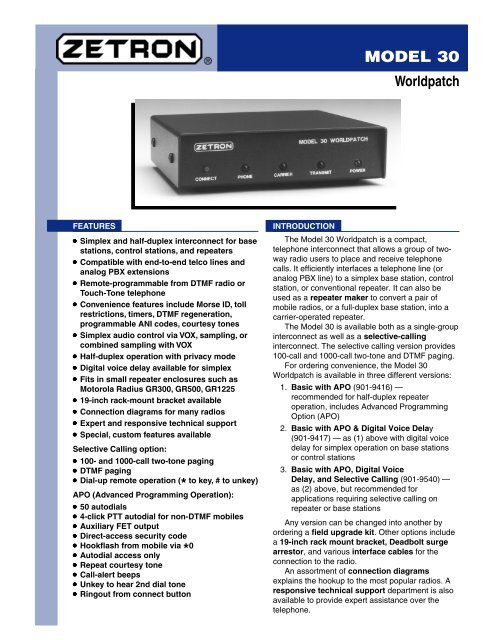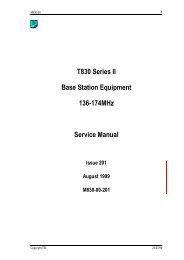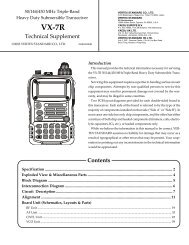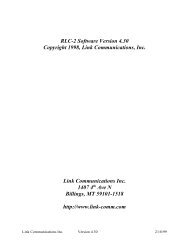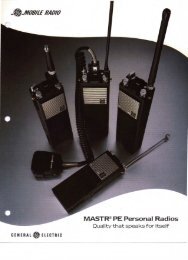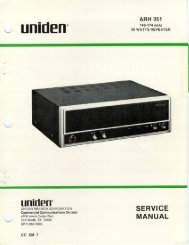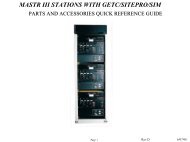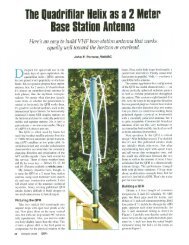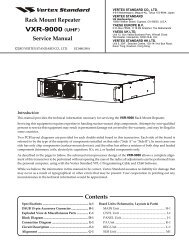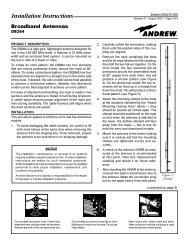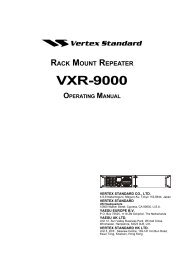Zetron Model 30 Worldpatch Brochure - The Repeater Builder's ...
Zetron Model 30 Worldpatch Brochure - The Repeater Builder's ...
Zetron Model 30 Worldpatch Brochure - The Repeater Builder's ...
Create successful ePaper yourself
Turn your PDF publications into a flip-book with our unique Google optimized e-Paper software.
MODEL <strong>30</strong><br />
<strong>Worldpatch</strong><br />
FEATURES<br />
● Simplex and half-duplex interconnect for base<br />
stations, control stations, and repeaters<br />
● Compatible with end-to-end telco lines and<br />
analog PBX extensions<br />
● Remote-programmable from DTMF radio or<br />
Touch-Tone telephone<br />
● Convenience features include Morse ID, toll<br />
restrictions, timers, DTMF regeneration,<br />
programmable ANI codes, courtesy tones<br />
● Simplex audio control via VOX, sampling, or<br />
combined sampling with VOX<br />
● Half-duplex operation with privacy mode<br />
● Digital voice delay available for simplex<br />
● Fits in small repeater enclosures such as<br />
Motorola Radius GR<strong>30</strong>0, GR500, GR1225<br />
● 19-inch rack-mount bracket available<br />
● Connection diagrams for many radios<br />
● Expert and responsive technical support<br />
● Special, custom features available<br />
Selective Calling option:<br />
● 100- and 1000-call two-tone paging<br />
● DTMF paging<br />
● Dial-up remote operation ( to key, # to unkey)<br />
*<br />
APO (Advanced Programming Operation):<br />
● 50 autodials<br />
● 4-click PTT autodial for non-DTMF mobiles<br />
● Auxiliary FET output<br />
● Direct-access security code<br />
● Hookflash from mobile via<br />
* 0<br />
● Autodial access only<br />
● Repeat courtesy tone<br />
● Call-alert beeps<br />
● Unkey to hear 2nd dial tone<br />
● Ringout from connect button<br />
INTRODUCTION<br />
<strong>The</strong> <strong>Model</strong> <strong>30</strong> <strong>Worldpatch</strong> is a compact,<br />
telephone interconnect that allows a group of twoway<br />
radio users to place and receive telephone<br />
calls. It efficiently interfaces a telephone line (or<br />
analog PBX line) to a simplex base station, control<br />
station, or conventional repeater. It can also be<br />
used as a repeater maker to convert a pair of<br />
mobile radios, or a full-duplex base station, into a<br />
carrier-operated repeater.<br />
<strong>The</strong> <strong>Model</strong> <strong>30</strong> is available both as a single-group<br />
interconnect as well as a selective-calling<br />
interconnect. <strong>The</strong> selective calling version provides<br />
100-call and 1000-call two-tone and DTMF paging.<br />
For ordering convenience, the <strong>Model</strong> <strong>30</strong><br />
<strong>Worldpatch</strong> is available in three different versions:<br />
1. Basic with APO (901-9416) —<br />
recommended for half-duplex repeater<br />
operation, includes Advanced Programming<br />
Option (APO)<br />
2. Basic with APO & Digital Voice Delay<br />
(901-9417) — as (1) above with digital voice<br />
delay for simplex operation on base stations<br />
or control stations<br />
3. Basic with APO, Digital Voice<br />
Delay, and Selective Calling (901-9540) —<br />
as (2) above, but recommended for<br />
applications requiring selective calling on<br />
repeater or base stations<br />
Any version can be changed into another by<br />
ordering a field upgrade kit. Other options include<br />
a 19-inch rack mount bracket, Deadbolt surge<br />
arrestor, and various interface cables for the<br />
connection to the radio.<br />
An assortment of connection diagrams<br />
explains the hookup to the most popular radios. A<br />
responsive technical support department is also<br />
available to provide expert assistance over the<br />
telephone.
RADIO-TO-PHONE CALLS<br />
To place a telephone call, a radio user keys up and<br />
enters the valid access code from the keypad of a<br />
DTMF microphone or handheld radio. Upon receiving<br />
dial tone, the user then dials into the public telephone<br />
network. Programmable toll restrictions can prevent<br />
long-distance dialing. Radio users can even be limited<br />
to dialing certain pre-programmed autodial numbers<br />
only (APO feature). Authorized personnel can bypass<br />
restrictions by entering the toll-restrict bypass code.<br />
<strong>The</strong> <strong>Model</strong> <strong>30</strong> can also provide limited telephone<br />
access to radio users who don't have DTMF keypads<br />
on their radios via the four-click autodial feature (APO<br />
feature). By clicking the PTT button four times, a radio<br />
user can cause the <strong>Model</strong> <strong>30</strong> to activate autodial #1.<br />
All calls are terminated when the radio user enters<br />
the disconnect code (separately programmable from<br />
the access code). <strong>The</strong> phone party may also<br />
disconnect a call by entering #0 on the telephone<br />
keypad. Conversation timers, busy tones, and dial<br />
tone can also terminate a call.<br />
PHONE-TO-RADIO CALLS<br />
If a telephone party (landline) wants to call a radio<br />
user, the phone party first dials the normal telephone<br />
number of the phone patch. This may be a standard<br />
seven-digit telephone number, or perhaps a 3-digit<br />
extension if the <strong>Model</strong> <strong>30</strong> is on a PBX system. After a<br />
number of rings before answer (programmable), the<br />
<strong>Model</strong> <strong>30</strong> picks up the line, keys up the transmitter,<br />
and broadcasts a ringing tone over the radio channel<br />
to alert the radio user(s) that a call is pending. <strong>The</strong><br />
<strong>Model</strong> <strong>30</strong> can either ring once on the channel, or ring<br />
repetitively. When ringing repetitively, the <strong>Model</strong> <strong>30</strong><br />
matches the ringing cadence of the local telephone<br />
system.<br />
A radio user can answer the call by keying up and<br />
entering the valid access code. Or, the <strong>Model</strong> <strong>30</strong> can<br />
be programmed to allow radio users to answer a call<br />
by just keying up (COR to answer), which allows non-<br />
DTMF radios to answer calls.<br />
For selective-calling versions, the sequence of<br />
events is somewhat different. After the <strong>Model</strong> <strong>30</strong> picks<br />
up the line, it prompts the phone party with a beep.<br />
<strong>The</strong> phone party then overdials the number of the<br />
desired radio (typically two or three digits) to be called.<br />
<strong>The</strong> <strong>Model</strong> <strong>30</strong> keys up the transmitter and broadcasts<br />
the corresponding paging tones, unsquelching the<br />
appropriate radio only. Other radios on the system are<br />
not disturbed.<br />
<strong>The</strong> <strong>Model</strong> <strong>30</strong> also has a direct-channel access<br />
mode. This puts the phone party on the air<br />
immediately, without ringing tones or overdial, as soon<br />
as the phone party dials the telephone number of the<br />
phone patch. <strong>The</strong> phone party may then voice-hail<br />
directly over the channel to gain the attention of radio<br />
users. To prevent unauthorized access, the phone<br />
party can be required to first enter a direct-access<br />
security code (APO feature).<br />
<strong>The</strong> <strong>Model</strong> <strong>30</strong> is ideal for connecting a<br />
standard telco line, or an analog PBX<br />
extension to a radio base station,<br />
control station, or repeater.<br />
BASE STATION INSTALLATIONS<br />
When connected to a simplex base station or<br />
control station, a phone patch is responsible for<br />
changing the station from receive to transmit at the<br />
right moments. <strong>The</strong> <strong>Model</strong> <strong>30</strong> can use VOX (voiceoperated<br />
transmit), sampling, or various mixtures of<br />
the two, depending on the demands of local<br />
conditions.<br />
In simplex installations, a <strong>Model</strong> <strong>30</strong> with the digital<br />
voice delay is recommended. This feature is a digital<br />
memory that delays the phone party's audio for a<br />
fraction of second (programmable 0.2-0.9 sec),<br />
allowing ample time for the transmitter to key up. <strong>The</strong><br />
delay prevents clipping of the phone party's first<br />
syllable.<br />
REPEATER INSTALLATIONS<br />
<strong>The</strong> <strong>Model</strong> <strong>30</strong> <strong>Worldpatch</strong> can be added to an<br />
existing, full-duplex repeater to allow radio users to<br />
make and receive phone calls. Or, the <strong>Model</strong> <strong>30</strong> can<br />
be used to create a repeater out of a separate<br />
transmitter and receiver, such as a pair of low-cost<br />
mobiles, or a full-duplex base station.<br />
To create a degree of privacy during<br />
interconnected calls, a half-duplex privacy mode can<br />
be enabled. When the radio user is talking to the<br />
phone party, the <strong>Model</strong> <strong>30</strong> will transmit a masking tone<br />
(instead of the radio user's audio) so eavesdropping<br />
mobiles will be discouraged from monitoring the<br />
conversation.<br />
With selective-calling versions of the <strong>Model</strong> <strong>30</strong>,<br />
radio users can be allowed to selectively call other<br />
two-way radios and pagers. After keying up and<br />
entering the sign-on code, the user enters a steering<br />
digit to indicate whether he wants to place a selective<br />
call or an interconnect call into the telephone system.<br />
<strong>The</strong>re are many features to assist with repeater<br />
conversations. A courtesy beep can be enabled, so<br />
every time a user finishes talking and releases the<br />
PTT button, the <strong>Model</strong> <strong>30</strong> transmits a quick beep to let<br />
the other user know to talk. <strong>The</strong> repeat hold timer can<br />
be set from 0 to 9 seconds to prevent other PL tones<br />
from interrupting a conversation. To alert conversing
mobiles that a call is coming in over the phone line, a<br />
call-alert beep can be transmitted at the same<br />
cadence as the telco ring cycle.<br />
If it is desired to have encode/decode of a single<br />
PL tone on the repeater, it's best to enable that<br />
capability in the repeater itself. If it's desired to have<br />
encode/decode of several PL tones or DPL codes–that<br />
is, to divide the repeater into different work groups–it's<br />
best to use an interconnected tone panel like the<br />
<strong>Zetron</strong> <strong>Model</strong> 48jr <strong>Repeater</strong> Patch rather than the<br />
<strong>Model</strong> <strong>30</strong>.<br />
DIAL-UP REMOTE<br />
<strong>The</strong> dial-up remote feature allows a phone caller<br />
to have positive control of a base station from afar.<br />
<strong>The</strong> phone party can dial the telephone number of the<br />
<strong>Model</strong> <strong>30</strong>, enter a security code, and immediately<br />
begin listening to the radio channel without the radio<br />
users being notified. If desired, the phone party can<br />
press to transmit, and release the transmitter by<br />
*<br />
pressing #. <strong>The</strong> dial-up remote feature allows a phone<br />
party to physically control the transmitter without<br />
having to rely on a VOX circuit.<br />
PBX APPLICATIONS<br />
<strong>The</strong> <strong>Model</strong> <strong>30</strong> is often installed on an analog line of<br />
a PBX telephone system. This lets PBX users reach<br />
field radios simply by dialing the extension occupied by<br />
the <strong>Model</strong> <strong>30</strong>. Several programmable items help<br />
support PBX applications. Radio users can generate<br />
hookflash signals into the PBX if necessary to control<br />
PBX features. A radio user generates a hookflash<br />
signal by pressing 0 during a call. Radio users can<br />
*<br />
also unkey their radios and verify a second dial tone<br />
when requesting an outside line.<br />
MANUAL OPERATORS<br />
A parallel telephone may share the line with a<br />
<strong>Model</strong> <strong>30</strong>. This gives a manual operator the<br />
opportunity to personally answer a call before the call<br />
is put onto the radio system. <strong>The</strong> <strong>Model</strong> <strong>30</strong> can be<br />
programmed to wait for up to 10 rings before<br />
answering the line.<br />
After answering a parallel telephone, an on-site<br />
operator can use the connect button on the front<br />
panel of the <strong>Model</strong> <strong>30</strong> to manually connect the<br />
telephone party to the radio system. If the <strong>Model</strong> <strong>30</strong><br />
has the APO feature set, then the connect button can<br />
even be used to transmit a ringing tone over the radio<br />
channel to alert the mobile users to take the call.<br />
INSTALLATION & MOUNTING<br />
<strong>The</strong> <strong>Model</strong> <strong>30</strong> is compact enough to fit in the<br />
industry's smallest repeater enclosures, including<br />
the Motorola Radius GR<strong>30</strong>0, GR500, and GR1225.<br />
Radio-specific cables are available to make the<br />
interface as quick and easy as possible.<br />
For proper installation in standard, 19-inch rackmount<br />
enclosures, an optional 19-inch rack mount<br />
bracket is available.<br />
<strong>The</strong> phone line connection on the rear of the<br />
<strong>Model</strong> <strong>30</strong> is a simple RJ-11 phone jack. <strong>The</strong> radio<br />
interface is a 10-pin modular plug with crimp pins<br />
provided. Level settings for transmit, receive, and<br />
carrier adjust are accessible on the back panel.<br />
All programming settings may be changed by<br />
remote control, without visiting the site.<br />
Programming takes place from a Touch-Tone<br />
telephone or keypad-equipped radio. Access to the<br />
program memory is protected by a programming<br />
access code. <strong>The</strong> installer may restore the unit to<br />
the factory default settings at any time.<br />
PHONE
STANDARD PROGRAMMABLE ITEMS<br />
Mobile-to-Phone Calls:<br />
ANI for access (1-9 digits)<br />
ANI to disconnect (1-9 digits)<br />
Validation for single digit ANI (y/n)<br />
Mobile dialing timer (0-60 sec)<br />
1st digit toll restricts (up to 4)<br />
2nd digit toll restricts (up to 4)<br />
Toll-restrict bypass code (1-8 digits)<br />
Regenerated dialing (DTMF or pulse)<br />
Busy tone disconnect (y/n)<br />
Dial tone disconnect (0-9 sec)<br />
Phone-to-Mobile Calls:<br />
Rings before answer phone (1-10)<br />
Ringing to radio (once or repetitive)<br />
Mobile answer method (ANI or PTT)<br />
Direct phone-to-radio access (y/n)<br />
Dial-up remote ( = key, # = unkey)<br />
*<br />
Conversation Control:<br />
Call limit timer (0-10 min)<br />
Call timer reset via mobile<br />
* (y/n)<br />
COR hold time (0.0-0.5 sec)<br />
Mobile activity timer (0-60 sec)<br />
Morse ID (0-8 digits)<br />
Morse interval (10 min time or activity)<br />
Phone courtesy tone (y/n)<br />
Programming access code (5 digits)<br />
<strong>Repeater</strong> Settings:<br />
Half-duplex repeater operation (y/n)<br />
Half-duplex privacy (y/n)<br />
Repeat audio (y/n)<br />
Repeat hold time (0-5 sec)<br />
Simplex Station Settings:<br />
VOX voice-operated transmit (y/n)<br />
VOX with pre-key (y/n)<br />
Sampling (y/n)<br />
Sampling & VOX-extended interval (y/n)<br />
VOX & sample between words (y/n)<br />
VOX before dial tone (y/n)<br />
VOX hold time (0.5-1.5 sec)<br />
Sample rate (0.5-1.5 sec)<br />
Sample window size (.01-sec steps)<br />
A.P.O. PROGRAMMABLE FEATURES<br />
Allow unkey to hear 2nd dialtone (y/n)<br />
Autodial access only (y/n)<br />
Autodials 0-49 (1-16 digits each)<br />
Call-alert beeps (y/n)<br />
Direct-access security code (1-9 digits)<br />
FET output turn-on code (1-9 digits)<br />
FET output turn-off code (1-9 digits)<br />
Hookflash from mobile via<br />
* 0 (y/n)<br />
Repeat courtesy tone (y/n)<br />
Ringout from connect button (y/n)<br />
4-Click PTT sends autodial #1 (y/n)<br />
SELECTIVE CALLING<br />
PROGRAMMABLE FEATURES<br />
Paging Format Choices:<br />
0. None<br />
1. DTMF<br />
2. 100-call 2-tone<br />
3. 1000-call 2-tone<br />
4. DTMF & 100-call two-tone<br />
5. DTMF & 1000-call two-tone<br />
Two-tone Paging Parameters:<br />
Tone groups (Mot 1-6,10,11,A,B,Z; GE A-C)<br />
Code plan (Mot B-Y,MT; GE X-Z)<br />
Timing (Mot; GE std; NEC A-D,L,M)<br />
Group or diagonal (replaces A or B)<br />
DTMF Paging Parameters:<br />
Digits entered by caller (1-8)<br />
Strapped digits (1-5)<br />
Strapped location (precede or follow)<br />
Other:<br />
Mobile-to-mobile paging (y/n)<br />
Note: the digital voice delay is adjustable 0.1-2.0 seconds<br />
on the delay board.<br />
SPECIFICATIONS<br />
GENERAL<br />
Power<br />
Temperature<br />
Size<br />
Weight<br />
Data Retention<br />
Secondary Protection<br />
11-16 VDC, 150 mA<br />
0-65 degrees Celsius<br />
5.9 x 7.4 x 1.7 inches<br />
2.5 lb<br />
Nonvolatile EEPROM, no batteries<br />
Telco high voltage clamps with<br />
protective fusing elements<br />
TELEPHONE INTERFACE<br />
Connector<br />
RJ11-C modular jack for one<br />
end-to-end (B1) phone line<br />
Incoming Call Ring detection on tip-ring pair.<br />
Programmable number of rings to<br />
answer<br />
Call Answer<br />
Off-hook, tip-ring current draw<br />
Call Disconnect Busy tone, dial tone, call limit, mobile<br />
activity timers<br />
Approvals FCC Registration Part 68<br />
Industry Canada<br />
RADIO INTERFACE<br />
PTT<br />
COR<br />
Tx Audio<br />
Rx Audio<br />
Tone Validation<br />
Auxiliary Output<br />
FET pull to ground<br />
External or internal carrier detector<br />
with squelch control<br />
-40 to +6 dBm. Hi/lo selector<br />
1Kohm output<br />
-40 to +10 dBm. Hi/lo selector.<br />
50Kohm input. 25 mV to 6 V P-P<br />
Contact closure input from CTCSS<br />
decoder<br />
FET pull to ground<br />
<strong>Zetron</strong>, Inc. PO Box 97004, Redmond WA 98073-9704 USA<br />
Ph: (425) 820-6363 Fax: (425) 820-7031 Email: zetron@zetron.com Web: http://www.zetron.com<br />
European Office: <strong>Zetron</strong>, Inc. 27-29 Campbell Court, Bramley, TADLEY, Basingstoke, RG26 5EG, UK Phone: +44 1256 880663 Fax: +44 1256 880491<br />
Australasia Office: <strong>Zetron</strong>, Inc. PO Box <strong>30</strong>45 Stafford Mail Centre, Stafford QLD 4053, Australia Phone: +61 7 3856 4888 Fax: +61 7 3356 6877<br />
See <strong>Zetron</strong> price list for option pricing. Specifications subject to change without notice. Literature number: 005-0339H July 2001


